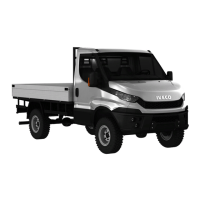18
DAILY 4x4 ‒ GUIDELINES FOR BODYBUILDERS
APPLICATIONS OF SUPERSTRUCTURES
3.7 INSTALLATION OF TANKS AND LOOSE MATERIAL CONTAINERS
– Printed 692.68.999 – 3 Ed. - Base 08-2020
3.7.2 Installation without a subframe
The application of tanks directly on the chassis is possible under the following conditions:
● the distance between the various rests must be established according to the load to be transmitted (approximately no more
than 800 m);
● the rests must be such that the load is evenly distributed over a suitably wide surface area and with appropriate bracings (see
Figure 12) to contain the longitudinal and transverse thrusts;
● the anchoring points must be of a sufficient length (approx. 400 mm – see Figure 13) and be positioned in the immediate
vicinity of the suspension connections.
Specifically, the front anchoring flexibility must be suited to contain the necessary torsional movements of the chassis;
● other anchoring solutions must be authorised by IVECO.
208921
Figure 13
The maximum volume, the degree of filling of the container and the volumetric mass of the transported goods must be defined
in observance of the axle weight limits. In the case of tanks and single containers made with separate compartments, the minimum
ratio between front axle weight and total fully loaded weight as well as the maximum loads on axles must be respected in all condi-
tions of load (see Chapter 1.15 ).
In consideration of the type of outfit, the use of vehicles equipped with stabilizer bars is recommended and particular attention
should be paid to limiting, as far as possible, the height of the overall centre of gravity (see Chapter 1.15 ); use of a vehicle with
stabilizer bars is recommended.
In tanks and containers for liquids, transversal and longitudinal partitions are to be used in. In fact, if these are not completely full,
the dynamic thrust which the liquid generates while the vehicle is in motion could negatively influence the vehicle's handling and
resistance.
Follow the safety laws in force for containers intended to carry flammable liquids (see Chapter 2.18 ).

